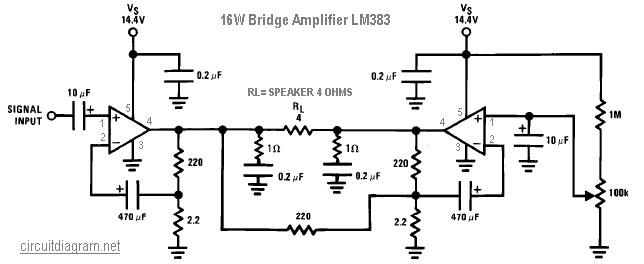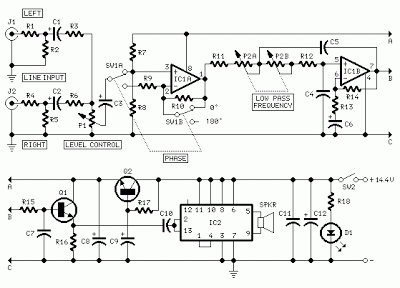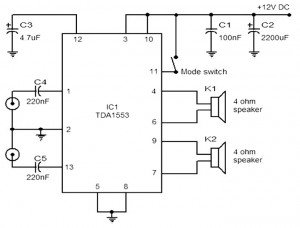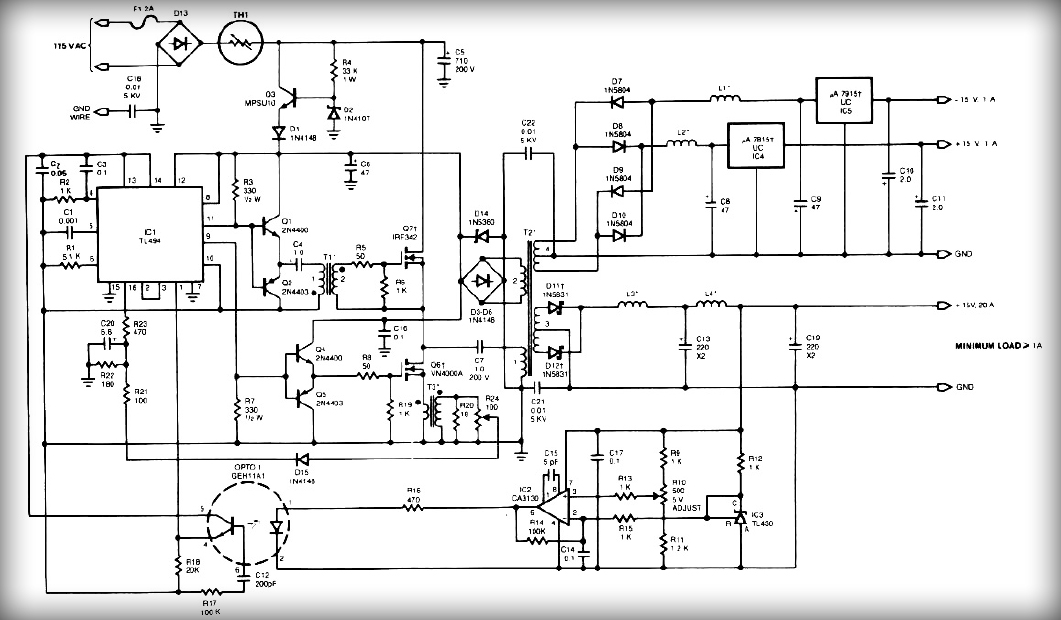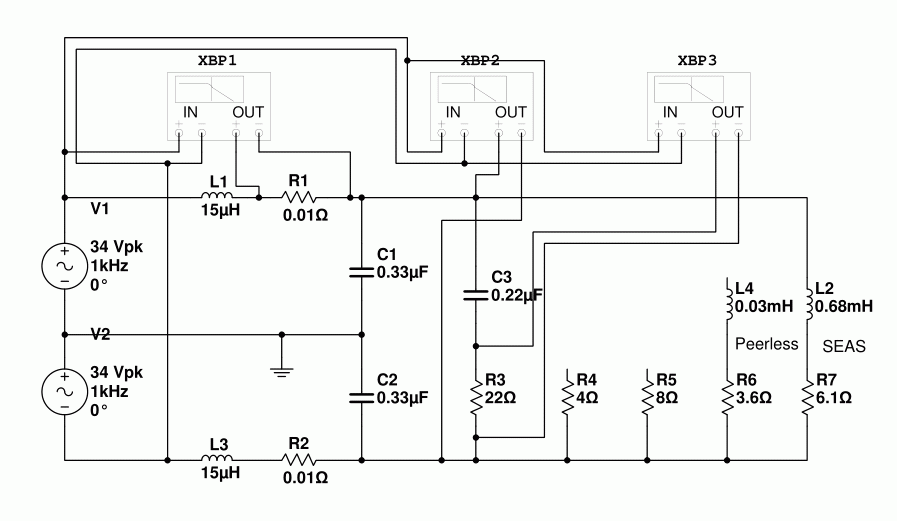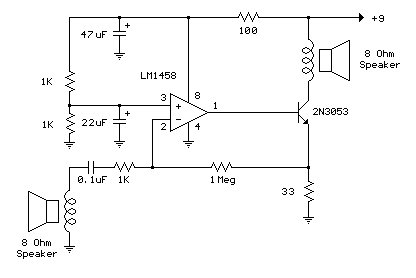
Audio Amplifier Schematic

A very high-power amplifier with 10 pairs of power transistors. It can utilize MJ15024 and MJ15025 or MJ21193 and MJ21194. These 20 transistors function as the final active components. The design is based on four integrated circuits: TL072, TL074, MN3101, and MN3004, which produce four channels of output, specifically for center, rear, front right, and front left surround audio. Additionally, there is a small amplifier capable of providing 7W output at 4 Ohms. Despite its modest output, this circuit is designed to achieve low total harmonic distortion and cross-talk. It consists of two identical mono amplifiers, with each channel having its own power supply. This Class A audio amplifier operates on a 50V supply and can produce very loud sound levels. Furthermore, a small and simple audio amplifier utilizing the TDA7294 is described. Two TDA7294 chips are employed for stereo operation (2G—80 watts) and bridge mode (180 watts).
This high-power amplifier design is notable for its use of 10 pairs of power transistors, which can be selected from the MJ15024, MJ15025, MJ21193, or MJ21194 models. These transistors are configured to serve as the final amplification stage, ensuring efficient power handling and output. The amplifier's architecture is enhanced by the inclusion of four operational amplifier chips: TL072 and TL074 for signal processing, and MN3101 and MN3004 for generating the four distinct audio channels. This configuration allows for the effective distribution of audio signals across the center, rear, front right, and front left channels, optimizing the surround sound experience.
In addition to the high-power amplifier, a compact amplifier circuit is described, which delivers 7W of output at a 4 Ohm load. This small amplifier is engineered to minimize total harmonic distortion (THD) and cross-talk, making it suitable for high-fidelity audio applications. The design features two identical mono amplifiers, each with an independent power supply, which isolates the channels and enhances performance. Operating in Class A mode, this amplifier requires a 50V power supply, allowing it to deliver high sound levels while maintaining audio quality.
Moreover, the TDA7294-based audio amplifier highlights versatility in its design. Utilizing two TDA7294 integrated circuits, the amplifier can function in both stereo mode, providing up to 80 watts, and bridge mode, which can output up to 180 watts. This adaptability makes it suitable for various audio applications, from home theater systems to professional audio setups. The TDA7294 is known for its efficiency and performance, making it a popular choice among audio engineers for building reliable and powerful audio amplifiers.A Very high power amplifier with 10 pairs of power transistor. Can use MJ15024 and MJ15025 or MJ21193 and MJ21194. Those 20 pieces transistor work as final active. [read more] Based on four chips, TL072, TL074, MN3101, and MN3004 which produce four channels of output, the center, rear, front right, and front left surround audio accomm. [read more] Very small amplifier witch can provide 7W/4Ohm output. This circuit, although have small output, but capable to produce output with low total harmonic and cross. [read more] Composed of two similar mono amplifier. Each channels has its own power supply. This class A audio amplifier take 50V as the fuel, and will produce very loud so. [read more] This is a small and simple audio amplifier with TDA7294. Using 2 TDA7294 for stereo (2G—80 watt) mode and bridge mode (180 watt). The TDA7294 for use as cla. [read more] 🔗 External reference
This high-power amplifier design is notable for its use of 10 pairs of power transistors, which can be selected from the MJ15024, MJ15025, MJ21193, or MJ21194 models. These transistors are configured to serve as the final amplification stage, ensuring efficient power handling and output. The amplifier's architecture is enhanced by the inclusion of four operational amplifier chips: TL072 and TL074 for signal processing, and MN3101 and MN3004 for generating the four distinct audio channels. This configuration allows for the effective distribution of audio signals across the center, rear, front right, and front left channels, optimizing the surround sound experience.
In addition to the high-power amplifier, a compact amplifier circuit is described, which delivers 7W of output at a 4 Ohm load. This small amplifier is engineered to minimize total harmonic distortion (THD) and cross-talk, making it suitable for high-fidelity audio applications. The design features two identical mono amplifiers, each with an independent power supply, which isolates the channels and enhances performance. Operating in Class A mode, this amplifier requires a 50V power supply, allowing it to deliver high sound levels while maintaining audio quality.
Moreover, the TDA7294-based audio amplifier highlights versatility in its design. Utilizing two TDA7294 integrated circuits, the amplifier can function in both stereo mode, providing up to 80 watts, and bridge mode, which can output up to 180 watts. This adaptability makes it suitable for various audio applications, from home theater systems to professional audio setups. The TDA7294 is known for its efficiency and performance, making it a popular choice among audio engineers for building reliable and powerful audio amplifiers.A Very high power amplifier with 10 pairs of power transistor. Can use MJ15024 and MJ15025 or MJ21193 and MJ21194. Those 20 pieces transistor work as final active. [read more] Based on four chips, TL072, TL074, MN3101, and MN3004 which produce four channels of output, the center, rear, front right, and front left surround audio accomm. [read more] Very small amplifier witch can provide 7W/4Ohm output. This circuit, although have small output, but capable to produce output with low total harmonic and cross. [read more] Composed of two similar mono amplifier. Each channels has its own power supply. This class A audio amplifier take 50V as the fuel, and will produce very loud so. [read more] This is a small and simple audio amplifier with TDA7294. Using 2 TDA7294 for stereo (2G—80 watt) mode and bridge mode (180 watt). The TDA7294 for use as cla. [read more] 🔗 External reference
